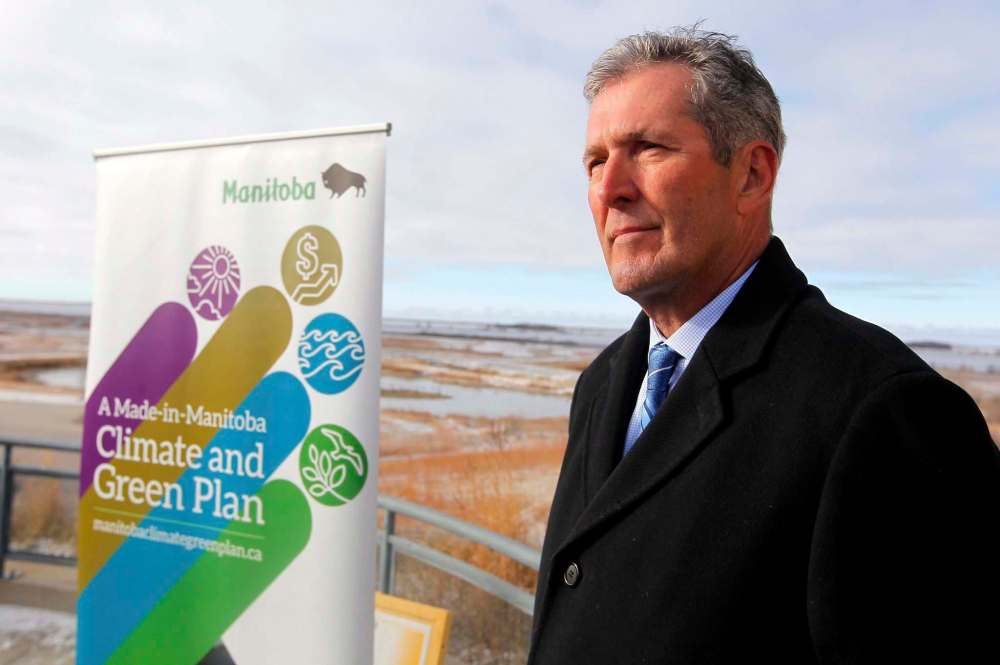Pallister not being straight with flat carbon tax claims
Advertisement
Read this article for free:
or
Already have an account? Log in here »
To continue reading, please subscribe:
Monthly Digital Subscription
$0 for the first 4 weeks*
- Enjoy unlimited reading on winnipegfreepress.com
- Read the E-Edition, our digital replica newspaper
- Access News Break, our award-winning app
- Play interactive puzzles
*No charge for 4 weeks then price increases to the regular rate of $19.00 plus GST every four weeks. Offer available to new and qualified returning subscribers only. Cancel any time.
Monthly Digital Subscription
$4.75/week*
- Enjoy unlimited reading on winnipegfreepress.com
- Read the E-Edition, our digital replica newspaper
- Access News Break, our award-winning app
- Play interactive puzzles
*Billed as $19 plus GST every four weeks. Cancel any time.
To continue reading, please subscribe:
Add Free Press access to your Brandon Sun subscription for only an additional
$1 for the first 4 weeks*
*Your next subscription payment will increase by $1.00 and you will be charged $16.99 plus GST for four weeks. After four weeks, your payment will increase to $23.99 plus GST every four weeks.
Read unlimited articles for free today:
or
Already have an account? Log in here »
Hey there, time traveller!
This article was published 02/05/2019 (2399 days ago), so information in it may no longer be current.
On April 4, Premier Brian Pallister was interviewed by Vassy Kapelos for the CBC program Power and Politics regarding his government’s decision to take the federal government to court over its imposition of a carbon tax in Manitoba. His stated reason for doing so was the inconsistent application of performance criteria by the federal government on provinces.
At one point in the interview, he said, “Why give offshore exemptions for Newfoundland and no credits for hydroelectric investments in Manitoba?” If the province proceeds with legal action against the federal government, the truth of this assertion will be tested by the courts.
However, the accuracy of other claims made by the premier in the interview can be tested against facts available to us now. There are several which simply do not stand up to the evidence. One is his boast that Manitoba is “the greenest jurisdiction in Canada” and that “Manitoba has been one of the greenest jurisdictions for the longest time.”

There are three facts which prove this claim false, all taken from the annual National Inventory Reports of greenhouse gas emissions prepared by Environment and Climate Change Canada for the United Nations Framework Convention on Climate Change. First, from 2005 to 2017, Manitoba’s greenhouse gas (GHG) emissions grew by 7.4 per cent, the third-highest rate in Canada. By comparison, in six provinces (British Columbia, Ontario, Quebec, New Brunswick, Nova Scotia and Prince Edward Island), the amount of GHG emissions fell by an average of 17.3 per cent.
Second, on a per-capita basis, Manitoba’s GHG emissions were fifth-highest in 2016, at 16,217 ktCO2eq (kilotonnes of carbon dioxide equivalent) per million population; and, per billion dollars of GDP, its emissions were fifth highest, at 358 ktCO2eq. By comparison, on both of these indicators, Quebec is the greenest province in Canada with GHG emissions of only 9,292 ktCO2eq per million population and 224 ktCO2eq per billion dollars of GDP.
A second falsehood perpetrated by Pallister in the interview was the claim that, “According to our experts, our plan will work better than the federal plan.” Yet, according to the R-GEEM modelling study commissioned by Manitoba in the preparation of its Climate and Green Plan report, by 2021, GHG-emission reductions under Manitoba’s proposed flat $25 per tonne carbon tax would lag those produced by the gradually increasing federal carbon tax by 13 ktCO2eq; and by 2023, cumulative emissions reductions under the federal plan will equal those achieved by the flat Manitoba carbon tax and then exceed them for the following years, out to 2030.
So, only for the first three years of its proposed 15-year green plan would the Manitoba flat carbon tax outperform the federal carbon tax.
In addition, Mr. Pallister failed to mention that the second GHG modelling study commissioned by the province (by EC-PRO) clearly shows that without a continually increasing carbon tax beyond 2022, GHG emissions will rise in Manitoba because of the effects of a growing economy and population. Only by a continuous annual increase of $10 per tonne in the carbon tax will it be possible to offset the impact of a rising GDP on GHG emissions.
A third misrepresentation of the facts committed by Pallister was his assertion that the “76 of the 77 pages (of its Climate and Green Plan report) we’re working on right now is more stringent that the one the federal plan proposes.” It is a false claim because, on page 16 of the report, he is comparing the reductions achieved by both the $25 per tonne flat tax plus a range of complementary initiatives with just the increasing federal carbon tax and no complementary measures.
When one includes both the federal carbon tax and the complementary measures, the advantage disappears, and over the full 15 years of the Manitoba plan (2018 to 2032), the combined federal carbon tax plus complementary measures would outperform the Manitoba flat carbon tax.
So, in sum, Pallister is misleading the Manitoba public about the superiority of his GHG-reduction plan. Manitoba is far from being the greenest province in Canada. That honour belongs to Quebec. Manitoba’s flat carbon tax would not outperform the federal sliding tax over the full 15 years of its proposed plan. By 2021, annual GHG emissions will be higher with the flat tax and the cumulative emissions will continue to increase.
Harvey Stevens was a member of the Manitoba Carbon Pricing Coalition.



